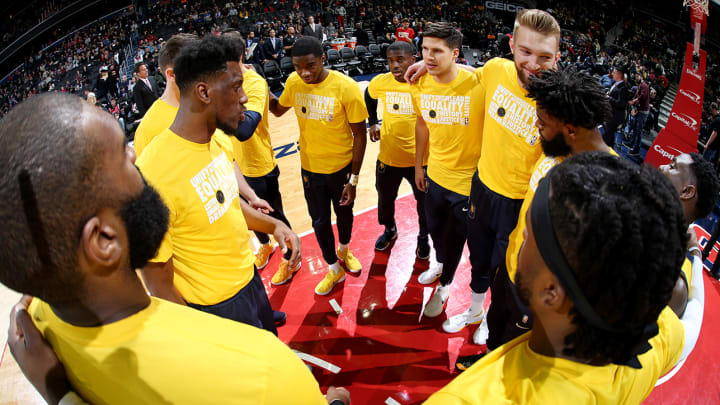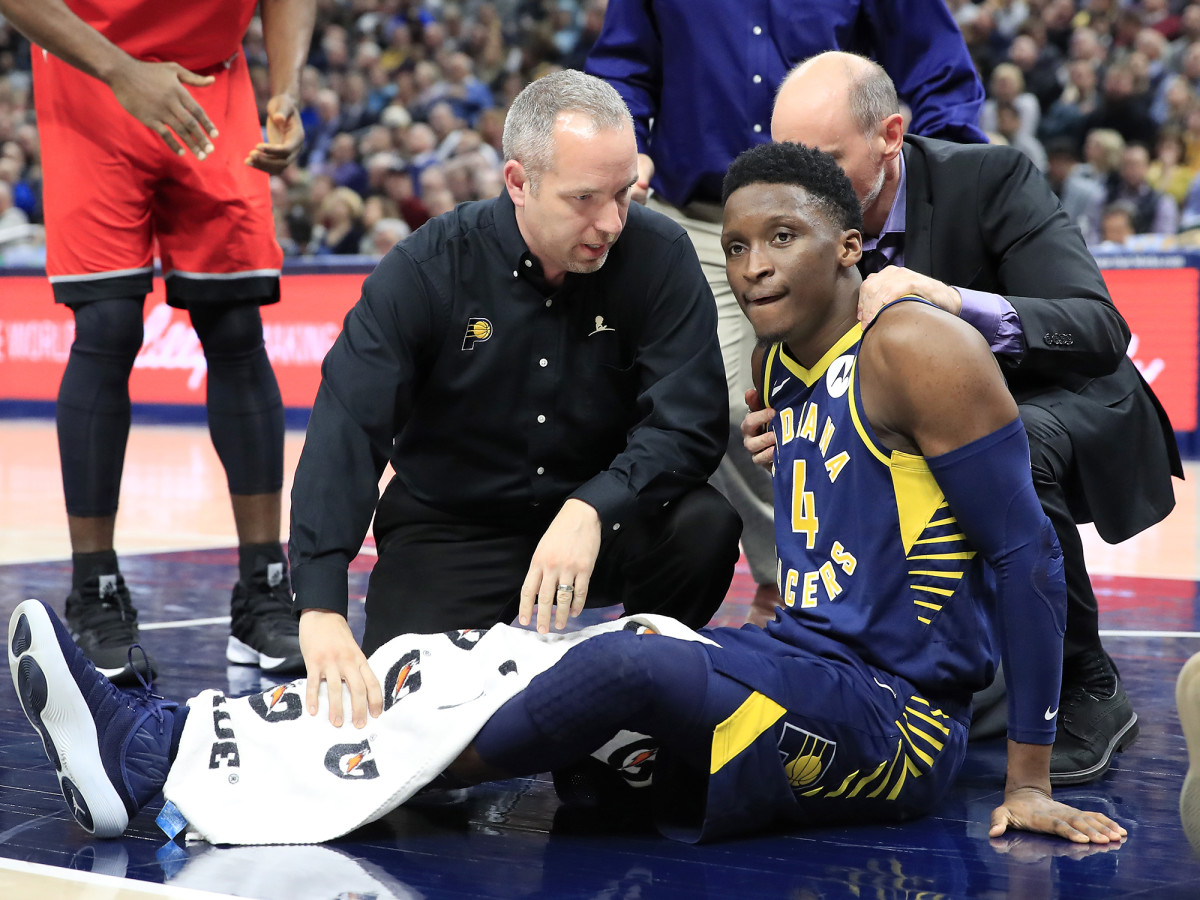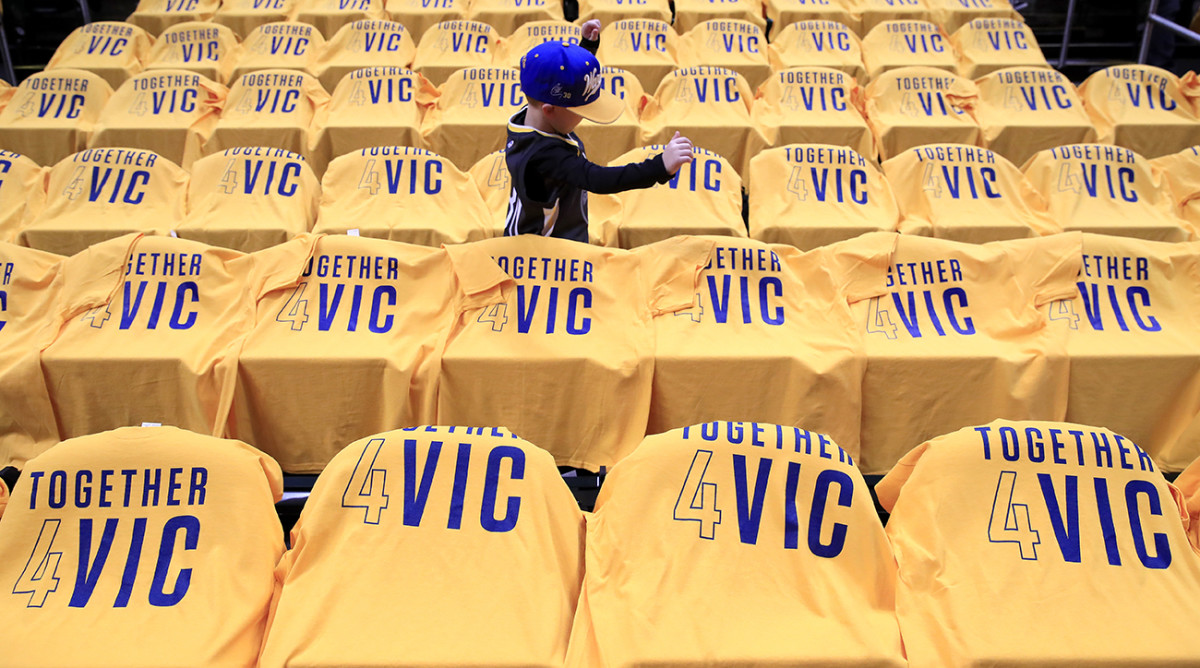Behind the Scenes of the Post-Oladipo Pacers: “No One’s Going to Feel Sorry for Us”

When Victor Oladipo rolled back the sleeve on his right knee, he couldn’t help but scream. It was obvious that something had gone wrong from the way he fell, as if his planted leg had gone straight through the hardwood while he raced back on defense. Seeing the cause—and the damage—separated his mind from his body. All Oladipo could do in the moment was wave desperately toward the Pacers’ bench, a sign center Myles Turner mistook for a desire to be helped up. Turner realized his error when he arrived on the scene. A trainer draped a towel across Oladipo’s shoulders. Another moved it to cover his knee. “From the sidelines,” Indiana coach Nate McMillan says, “I saw his kneecap out of place.”
Thaddeus Young, the team’s veteran power forward, knelt beside Oladipo. Young told him, “Everything is going to be fine.” Whether that was true was beside the point. Young wanted Oladipo to focus on his words rather than on the gurney that was being wheeled onto the floor of Bankers Life Fieldhouse that January night. “Letting him know that we’re here for him as a team,” Young says. “As brothers.”
Back in the training room, shortly before halftime, team president Kevin Pritchard waited for his All-Star shooting guard. Oladipo never showed; he had been taken straight to the X-ray machine, a sign of the severity of the injury. “The biggest thing for me was just walking into that X-ray room,” Pritchard says. “It just felt like there was a cloud. Sometimes in the world, you can feel things. You could feel it right then.” Oladipo’s season was over. Doctors would later diagnose that his right quad tendon—a bit of tissue above the kneecap that is not usually a source of basketball injuries—had ruptured. Staff gathered around Oladipo with long faces, some speaking in past tense. “Hey, fellas,” he told them, “I ain’t dead.”

Neither were the Pacers, then the third-place team in the East. There was still a 12-point halftime lead to protect against Toronto. Young championed a provisional offense that gave ground but never buckled. After a 110–106 victory, Pritchard addressed the team at McMillan’s request. As he stood on the Pacers’ logo in the center of the locker room, he said that Oladipo was likely to be out for the season. Then he asked, Do you know what your record is without Vic? It was 7–4, to the surprise of many, since they had gone 0–7 the season before. Did you know that you’re five points better than your opponents, even without Vic on the floor? “We didn’t,” Young admits. There’s no solution for the loss of a leading scorer in a night, but the Pacers left the building encouraged.
Some teammates and coaches texted Oladipo right away. Others chose to give him space. Young drove home with his wife and sons, parked his white Escalade in the garage and called up the 26-year-old Oladipo on the darkest night of his career. He was met, on the line, with laughter. “I’m good, man,” Oladipo said, ebullient as ever. “Everything’s gonna be great.” Young had hoped to lift Oladipo’s spirits. Instead, he found that Oladipo, who sat with his leg elevated and kneecap awry, had reassured him.
This isn’t the story of an injury. This is the story of what comes next.
The path to the courts of the Pacers’ practice facility cuts through the training room and past an oversized red button. On it, in plain white lettering, is the word RESET. It originates with Oladipo. Back in the summer of 2017, Indiana traded Paul George to Oklahoma City for Oladipo and Domantas Sabonis, a return widely thought to be underwhelming in NBA circles. Both had become wallflowers with the Thunder. What skill Sabonis had shown at Gonzaga disappeared when he was parked in the corners, left to await Russell Westbrook fastballs and the stare-downs that followed each missed shot. And as much as Oladipo admired Westbrook, he had trouble modulating his playing style alongside him. How does one coexist with a volcano? Oladipo felt the fire but could never find stable ground. When the Thunder needed him to assert himself, he deferred. When the situation called for him to be a more passive threat, he was never quite comfortable. Oladipo’s one-year stint in OKC ended all too quietly.
When he arrived in Indy, Oladipo told team officials that he had much more to offer. A long summer and a short memory set up Oladipo for a career year: an All-NBA, All-Star, All–Defensive Team campaign that revitalized the Pacers, who improved from 42 wins to 48. “He came in here, and he completely changed an organization,” Pritchard says. “His mentality and his approach set the tone.”
Last summer Pritchard, GM Chad Buchanan and senior vice president Peter Dinwiddie met with Oladipo in Miami, where he grinds through the offseason. They watched one of the marathon training sessions that had transformed his career. Afterward the group went to dinner at Prime 112, the preferred steak house of the NBA set. As they discussed Oladipo’s progress over dry-aged beef, he let the table in on his secret. “I hit the reset button every day,” Oladipo said. The visual stuck, and Buchanan had the idea to make it real.
If there was ever a need for that button, it was on Jan. 24, the day after Oladipo’s injury. The Pacers allowed themselves the night to digest what had happened. The next morning they sifted through the practical fallout. “It was, How are we gonna fill this spot right now?” assistant coach Dan Burke recalls. “What are we gonna do this practice? What are we gonna do this game?” Minds tend to race in moments of turmoil, but McMillan kept a short-term focus. Forget the playoffs. To have any hope of reaching them, the Pacers had to get through today. “I try to stay in the moment,” McMillan says. “Hell, you’ll kill yourself stressing out about all of that.”
The coaches discussed whether any schematic changes were needed after losing the one player who could consistently break defenders down. They opted for incrementalism. There was no cause to throw out the playbook when so much of the offense was already predicated on movement and off-ball screening. All they needed was a slight shift in gear. “It’s like driving in the snow,” McMillan says. “You have to adapt and slow down. If it’s sunny, I can go 70. With Victor, we could go 70. We’re not that type of team anymore.” The execution would have to be more deliberate, more precise. What was a moderately paced offense at the time of Oladipo’s injury would eventually become one of the slowest.
In a cruel twist of metaphor Tyreke Evans, Oladipo’s backup, injured his back when his car slid off a snow-covered road the night the Pacers returned from their first game without Oladipo, a 106–103 loss at Memphis. Replacing him would require a 500-mile road trip across the frozen Midwest.
Edmond Sumner got word of Oladipo’s injury during halftime of his own game for the Fort Wayne (Ind.) Mad Ants, Indiana’s G League affiliate. An assistant coach warned Sumner that a call-up could be coming. It was a reasonable assumption for a 6' 6" guard on a two-way contract who had come to know the route from Fort Wayne to Indianapolis well. He finished his game against the Erie (Pa.) Bayhawks with 33 points and five assists. Around 10 p.m., Sumner got a call from Buchanan informing him that he would be returning to the Pacers as soon as possible.
As soon as possible can lead to some interesting scenarios for G Leaguers who zigzag the country by bus. After a night in an Erie hotel, Sumner & Co. rode to Canton, Ohio, where he was picked up by Chris Taylor, Fort Wayne’s director of basketball operations. The two convened in the basement of Mad Ants coach Steve Gansey’s mother, Gale, who had hosted the team for lunch. Then they hit the road for Fort Wayne, where Sumner picked up his own car and made the drive down to Indianapolis. The absurdity of the circumstances was not lost on Taylor. “One day you’re playing fantastic in the G League, helping the team win, putting up major numbers,” he says. “Something happens, and you’re riding with a staff member through the Middle-of-Nowhere, Ohio, and then the next night you’re starting against the defending champions.”
The matchup against the Warriors, Indiana’s first home game since the injury, provided an ideal chance to send a message. “Really,” Pritchard says, “I wanted something that Victor would see on TV.”

Just hours after watching Oladipo’s injury, Pritchard had phoned COO of Pacers Sports & Entertainment Rick Fuson, who then called Todd Taylor, head of the franchise’s marketing arm. At 8 a.m. the next day, Emily Cornforth, the Pacers director of marketing and fan engagement, reached out to MainGate, an Indianapolis-based merchandise supplier, and placed an order for more than 20,000 gold T-shirts to be screen printed and delivered in four days.
The gold-out is a Pacers playoff staple, drawing on the most distinctive color in their palette. Gold, in industry terms, is very “ownable.” Yet what is usually a strength of the brand can become an inconvenience when searching for 20,000 shirts at a moment’s notice. To even secure that many took some doing. To then print and ship them in time for the game against the Warriors swamped MainGate’s entire production line. Finished shirts were packed, 72 to a box, and trucked to the Fieldhouse the morning of the Warriors game. Each one bore the same message: TOGETHER 4 VIC. Fifty Pacers employees volunteered to lay out a shirt on every seat. “We bribe our staff with pizza, pretty much,” Taylor says. They finished the job in 75 minutes.
When Oladipo woke from surgery that morning in Miami, he was met by a traveling party of family, friends and Pacers staff, each in a newly printed gold shirt. Oladipo wanted to send a message of his own. With Buchanan as his cameraman, Oladipo sent thanks to the fans from his hospital bed. “The surgery was amazing,” Oladipo said. “It was truly a success, and I’ll be back better than ever. Everybody stay feathery.” The clip played on the video board—2,800 square feet of Oladipo flanked by IV bags and medical supplies—that night to a rousing ovation.
Then Indiana took the court and got run off the floor—132–100, its worst loss of the season. Says Young, “We were just really unsure of what to do.” Some players pressed. Others lost focus. What had been one of the NBA’s best defenses gave way under the slightest pressure. One loss became two, then three. “It was like we were rolling over,” Turner says. It was understood that an offense without Oladipo, who led the team in usage, would need time to recalibrate. The Pacers appeared to be suffering from some deeper confusion—a crisis of role and identity that threatened their entire season. Even before Oladipo went down, they could not survive lapses in effort or discipline; they overachieved by investing more into each possession than their opponents. They didn’t win with highlight-reel plays but by making the third defensive rotation.
Players cite a 107–100 loss at Orlando, the fourth without Oladipo, as the turning point. “That’s when we figured out how we need to play,” Young says. The ball began to move without the weight of expectation. Forward Bojan Bogdanovic struck the perfect chord with his drives out of the pick-and-roll. Help in coverage came intuitively. “Even though we lost the game,” Sabonis says, “we started getting that chemistry back.” A day later, the team would be made whole again.

After traveling from Orlando to Miami, the Pacers received a group text to coordinate a reunion with Oladipo at the Ritz Carlton. Players and coaches found Oladipo propped up on the couch in his suite, a pile of books at his side. The Inner Game of Tennis. A cookbook. The Subtle Art of Not Giving a F***. They were welcomed, as usual, with serenades. “I mean, his life’s a musical,” Burke says. “Bojaaaaaan!” Oladipo called to his Croatian teammate, in signature, sing-song fashion. “It was just like nothing ever happened,” Young says. Teammates caught up, watched the Celtics take on the Knicks. Seeing Oladipo again was both a lift and a reality check. The Orlando loss had dropped the Pacers to tied for fourth in the East. “No one’s gonna feel sorry for us,” Oladipo told the team. “We’re gonna have to go figure it out.”
Indiana has gone 9–4 since and is back up to third. You don’t replace a player like Oladipo so much as find your own way. The addition of veteran shooting guard Wesley Matthews has stabilized the rotation, keeping Evans in a reserve role while Sumner and Aaron Holiday play spot minutes. Some of the sets that went to Oladipo now go to Evans or to Matthews or to point guard Darren Collison, tailored to their talents. “I didn’t post up Victor, but I can post up Tyreke,” McMillan says. “I didn’t post up Victor, but I can post up Wesley.” In the absence of a single, explosive creator, Indiana allows even more of its offense to flow through Sabonis.
The Pacers only need to score enough points to clear one of the lowest—and therefore best—defensive ratings in the league. Every stop is predicated on keeping a defender square to the ball at all times. Overplays are rare. This allows the Pacers to ward off the straight-line attacks that compromise defenses. Whatever slips through can then be repelled by Turner, a natural shot blocker who has become a defensive keystone. A stopper isn’t as valuable as defensive fluency. “Tyreke told me one time, ‘I’m a bad one-on-one defender,’ ” recalls Burke, the architect of Indiana’s defense. “That’s O.K.! I think you’re better than you think you are. But can you be a great team defender?”
“I look to someone like Bojan,” Turner says. “Bojan’s always been an offensive kind of guy, but he’s taken pride in guarding the other team’s best player because he knows he has help.”
McMillan doesn’t actually know, night to night, where his team’s scoring might come from. Six Pacers have put up 20 points in a game post injury. Bogdanovic could go for 37 or 12. Turner could get 16 shots or just nine. There is an unpredictability that attends that kind of balance. Opponents, unsure of where to apply pressure, have been switching more in hopes of encouraging career role players to attack one-on-one. McMillan used some of the team’s rare practice time coming out of the All-Star break to introduce a few counters, but there’s only so much the Pacers can do. Stars give a team its shape. As long as Oladipo is out, parts of Indiana’s offense will live and die in free-form.
The past month of Pacers basketball has been a triumph over circumstance, but the next will be trial by combat. They have one of the five most difficult remaining schedules by opponents’ winning percentage. For all the makeshift solutions he has found, McMillan is still just a coach trying to get through the next practice. “The NBA,” he says, “is about adapting. Foul trouble. Injury. Team getting hot. Your lineup not playing well. Rotating different guys in and out. So you are constantly adapting throughout a game.” Managing that process without Oladipo only makes it more of a challenge.
Oladipo is already back on the court, in a sense, doing reflex drills with medicine balls and taking form jumpers from a training table. It could be months before he moves freely. “We’re gonna evaluate on a weekly and monthly basis, and from what we hear, a year from his injury is a good time,” Pritchard says. “But there are people that are a little before that, and then there are people that take a little longer. The one thing we want to be perfectly clear is that his body will let him know, and we will listen to him and his body and allow him to be a big part of the process.”
So begins a comeback of intimidating proportion, carried out by both player and team. Oladipo will rehab from his table until he can stand on his own feet. He will work out of Miami until his surgically repaired tendon has begun to heal, at which point he can return to Indianapolis for more arduous rehabilitation. He will rebuild his knee first from the training room and, once he’s ready, cross the threshold back out to the court, past the red button. The only play that matters is the next play. The only day that matters is today.
